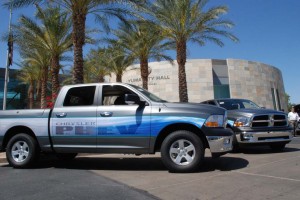Chrysler and the U.S. Department of Energy have delivered the first 10 Ram 1500 plug-in hybrid electric pickup trucks to Yuma, Ariz. for testing in the region’s extreme summer climate. Fittingly, they’ll also be used to put the heat on criminals.
Eight of the experimental trucks will be modified and used as patrol vehicles by the Yuma Police Department, according to the Yuma Sun newspaper.
Jerry Geier, Yuma’s police chief, said he’s “really looking forward to the trucks…getting them outfitted and out on patrol and putting them to use.”
The trucks rely on a 345-horsepower, 5.7-liter Hemi V-8 mated to a modified version of Chrysler’s two-mode hybrid transmission. A 12.9 kilowatt-hour lithium-ion battery has been substituted for the smaller, nickel-metal hydride battery in Chrysler’s conventional hybrid system.
The system is expected to yield about 20 miles on pure battery power – and up to 655 miles on a tank of gas. The performance of the big V8 isn’t compromised by the hybrid drive, so it can tow up to 6,000 pounds and carry a payload of up to 1,000 pounds.
The trucks have several advantages over conventional police cars. Besides getting at least 32 miles per gallon in the city, the combined gas-electric drivetrain boosts gets a total 399 horsepower. The PHEV Rams also can generate 6.6 kilowatts of electricity to provide emergency power when needed, such as for spotlights at an accident.
The remaining two PHEV Rams will be used by Yuma’s Utilities Department for customer service, such as water hookups, shutdowns and meter reading.
The trucks going to Yuma are part of a broader test fleet of 140 plug-ins that Chrysler wants to evaluate over the next three years, according to Chrysler engineer Curtis Semak. While lithium batteries prefer to operate at temperatures of around 70 degrees, automakers have to find ways to make them work in much more challenging situations.
So, Chrysler has chosen a variety of locations that will push the Rams to the extremes in terms of temperature – anywhere from -20 to 125 degrees – humidity and driving situations. By the time the experiment ends, the maker expects the test fleet to have clocked over 7 million miles. And it has set up the 140 plug-ins to regularly report back by using a special satellite feed.
The project is being funded by a $48 million Department of Energy grant, along with another $49.4 million from Chrysler itself.
The automaker also plans to begin field testing a fleet of 25 plug-in minivans next year.
Paul A. Eisenstein contributed to this report.

